
The year is 1954 and the New York City summer is sweltering. L. B. Jeffries, injured while photographing a motor race, is in a cast from the waist down. Bored, he takes to looking out the large windows of his apartment and into the courtyard—and the windows of his fellow apartment dwellers. A touch voyeuristic, perhaps, but no harm done…until Jeffries sees enough strange things through one apartment window to become convinced a murder has taken place. But how to convince anyone else that he’s right, and how to prove it?
The year is 2022 and Prospero Hall puts out a new game about the people and actions taking place in those apartments. Can The Director help the others to guess who they are and what they’re doing? Or is The Director trying to cover up a murder?
Based somewhat loosely on Alfred Hitchcock’s film Rear Window, the board game of the same name, takes place over four rounds and focuses on the people and attributes of four apartments as seen through their windows.
Setting Up the Game
Choose one person to play The Director and give them the Director’s Screen. As well, they’ll take the four black wooden cubes, all three Cut tokens, the deck of Window cards, the Trunk, and the Solution board. The Solution board is placed behind the Director’s Screen, and will not be shown until the end of the game.
Set the four Day boards out, each one face down, with the text facing the other players.
The other players, known as The Watchers, take The Watchers’ Screen, the four Watcher placards, and the tray of Residents and Attributes.
From the tray, they’ll take one token of each resident and hand them to The Director, setting the others out in front of them.
Then choose any twelve Attributes from the tray. Give one of each, face down, to The Director, along with a Murder tile. Set the remaining Attributes face up, along with the other Murder tile, next to your Watcher’s Screen.
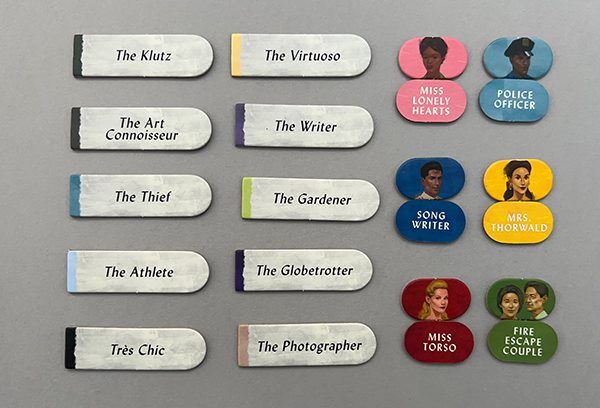
The Director selects four of the face-down Attribute tiles they were given and places one each on the appropriate spaces on the Solution board. Four Resident tiles are randomly assigned to the Attributes.
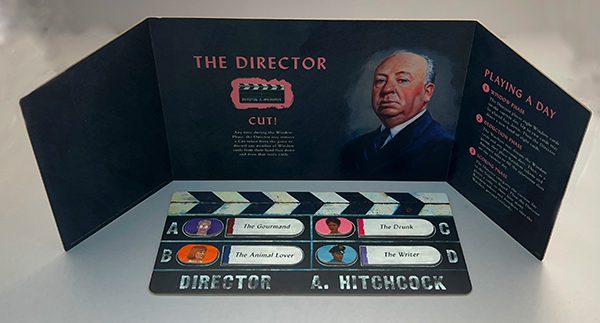
The remaining Attribute and Resident tokens are placed in the cardboard Trunk and the lid is closed. This keeps the unused items a secret from The Watchers.
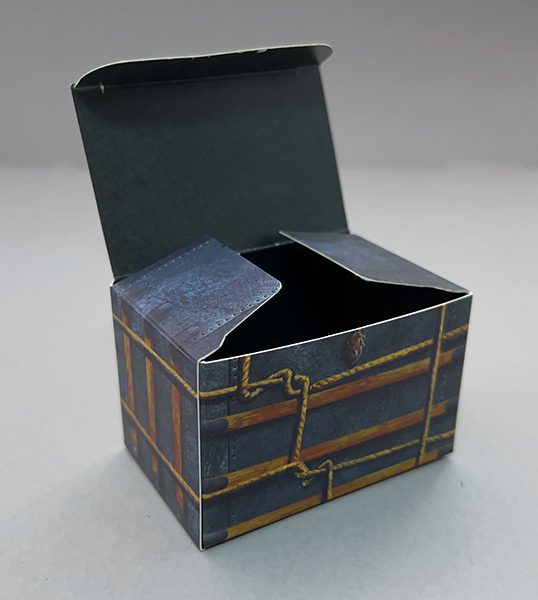
The Director then draws eight Window cards. These cards each feature scenes, as seen through Jeffries’ window, occurring in the various apartments. Some will feature characters, either in person or in pictures on the wall, or in shadow, as well as any number of different items and settings.
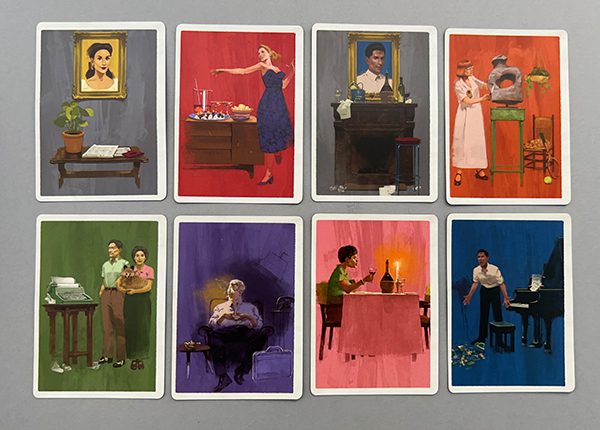
The board for Day One is turned over. The Director looks at their eight cards and places them, two per apartment, in such a way as to give The Watchers clues as to the Resident and the Attribute listed for that apartment on The Director’s Solution board.
If The Director feels too many of their cards are unhelpful or misleading, they can choose to use one of their three Director’s Cut tokens. This allows The Director to exchange as many Window cards as they wish and draw up to the same number of new Window cards.
However, if The Director believes only a scant few cards are unhelpful, they may choose to place the card face down/window side up, instead of using a Director’s Cut token.
NOTE: The Director is silent for the game. They cannot give any clues to The Watchers at any point, not even to let them know if a murder was committed or not.
Then it’s time for The Watchers to examine what clues they’ve been given. They can discuss theories before finally placing a set of Resident and Attribute tokens at each of the four apartments as their guess.
The Director then takes one of their black cubes and places it on the number of guesses The Watchers guessed correctly.
The next Day’s board is turned over, and eight new Window cards are placed on the apartments windows.
The Watchers have four helpers from the movie at their disposal. These grant the Watchers one-time powers to either replace or view a face-down Window card or confirm/deny aspects or guesses of a Window card.

This continues until the end of Day Four, when the final guesses are made.
In true cooperative gameplay, everyone wins if The Watchers get all eight aspects correct!
Unless a murder has been committed.
Murder!
In the film, there is a real question as to whether a murder has actually been committed. Jeffries seems to have compelling anecdotal observations that point to murder, but his old war buddy, Detective Tom Doyle shoots those ideas down one after the other.
In the board game, there’s also a real question about murder. And about the reliability of The Director to be telling the truth about all the Residents and their Attributes.
Remember that lone Murder token The Watchers handed The Director with the other Attributes? If the Murder token is randomly selected, the game changes. No longer are all players working cooperatively to guess the four Residents and their Attributes. When Murder enters the game, the roles and the conditions required for either side to win the game changes.
Here the game changes from a cooperative affair to an adversarial one. Now The Director must (a) help The Watchers to correctly identify six or seven Residents/Attributes correctly with (b) a murder not being correctly guessed on Day Four. Meanwhile, The Watchers will win if, on Day Four, they guess seven or eight Residents/Attributes correctly, including the Murder tile.
The concept of a potentially unreliable Director sets Rear Window apart from other games in this genre. Window cards can be difficult to helpfully play in the best of circumstances, but what if The Watchers suspect The Director is intentionally trying to mislead them? And, if so, who was murdered and where? Was that Window card played face down because it wasn’t helpful—or was it possibly too helpful with regards to a murder so it needed to be placed face-down?
Thoughts
In my younger days, I spent a lot of time in movie theaters. Between retro movie houses and my attempt at getting a degree in film studies, I watched a lot of classic films. Hitchcock was a favorite director, and Rear Window was a film I watched more times than I can remember.
As well, I’m a big fan of social deduction games. So, it’s no surprise the idea of such a game based on the movie was one I wanted to play.
While it’s not essential to have seen the movie prior to playing Rear Window, some of the Residents will certainly make more sense if you have. (Miss Torso and The Fire Escape Couple’s names aren’t explained in the rules, only in the movie.) However, it’s also possible to read more into the Window cards based on the actions and attributes of the film characters that may not be true of the game’s Residents.
That being said, there are a number of terrific, subtle nods to the movie throughout the game. Remember the Trunk, the cardboard ‘box’ The Director uses to hide away the unused Resident and Attribute tokens? That’s the trunk Thorwald supposedly used to dispose of his wife’s body in the movie.
And take a look at the game’s rule book.

This photo is shown in the early, scene-setting shots of the film. Seen on a table in Jeffries’ apartment, it’s the photo of the racing crash that put L.B. in the body cast he spends the film in.
Also, the Murder token has an exclamation mark. Murder! is the title of a 1930 film by Hitchcock.
These things make this old film studies major’s heart very happy.
The box is exactly the right size for the cards, boards, and the components. And speaking of components, take a look at this great organizer for the Residents and Attributes tokens.

My appreciation goes out to the Prospero Hall design team for this. It’s so nice to work with.
If you think Rear Window’s Window cards have a slight Mysterium feel to them, you’re right. Although the Window cards are not nearly as surreal and dreamlike as the vision cards in Mysterium, there are plenty of potential red herrings to work through on each card. (Does that card point to the Fire Escape Couple because they’re pictured? Or does dog indicate The Animal Lover? Maybe the typewriter means they’re The Writer? Or perhaps the green background is trying to link to the green edge of The Klutz Attribute token?)
“Was there a murder?” is a central part of the film, so it makes sense that it should also be a part of the game. That can they or can’t they be trusted aspect of the game can be difficult to manage during a first play. My first games were done without the Murder token being in play to give everyone a better chance at learning the game.
That being said, unlike in the film (after all, it was directed by Hitchcock), there’s only a one-in-thirteen chance that a murder has been committed in the game. But, as with the movie, that possibility, no matter how remote, still makes for a suspenseful game.
However, that brings me to another important consideration.
Unlike the social deduction game Whitehall Mystery, this is not a game where you’re chasing a hidden player across the board. Rear Window is more of a logic puzzle where you’ll likely spend your last turn checking your guesses against the number of right answers from your previous days.
Of the two groups I’ve played Rear Window with, the one who I’ve played Whitehall Mystery with over a dozen times immediately said they wanted to play again. One of my weekly gaming group said that while he liked it, he didn’t feel the need to ever play it again after the lengthy logic check on Day Four.
Both are very fair reactions. As usual, it all depends on the people you’re playing with.
I come down solidly on the side of playing it again. And again. Rear Window is a solid, fun game that encourages discussion and cooperation amongst The Watchers. And, like the film, there’s just enough potential paranoia to keep you fully engaged in the stories before you.





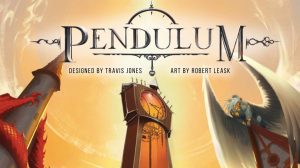






“That being said, unlike in the film (after all, it was directed by Hitchcock), there’s only a one-in-thirteen chance that a murder has been committed in the game.”
Four out of thirteen Attributes are assigned to apartments, so there’s a 4/13 or around a 31% chance of a murder.
I stand corrected. Thanks.